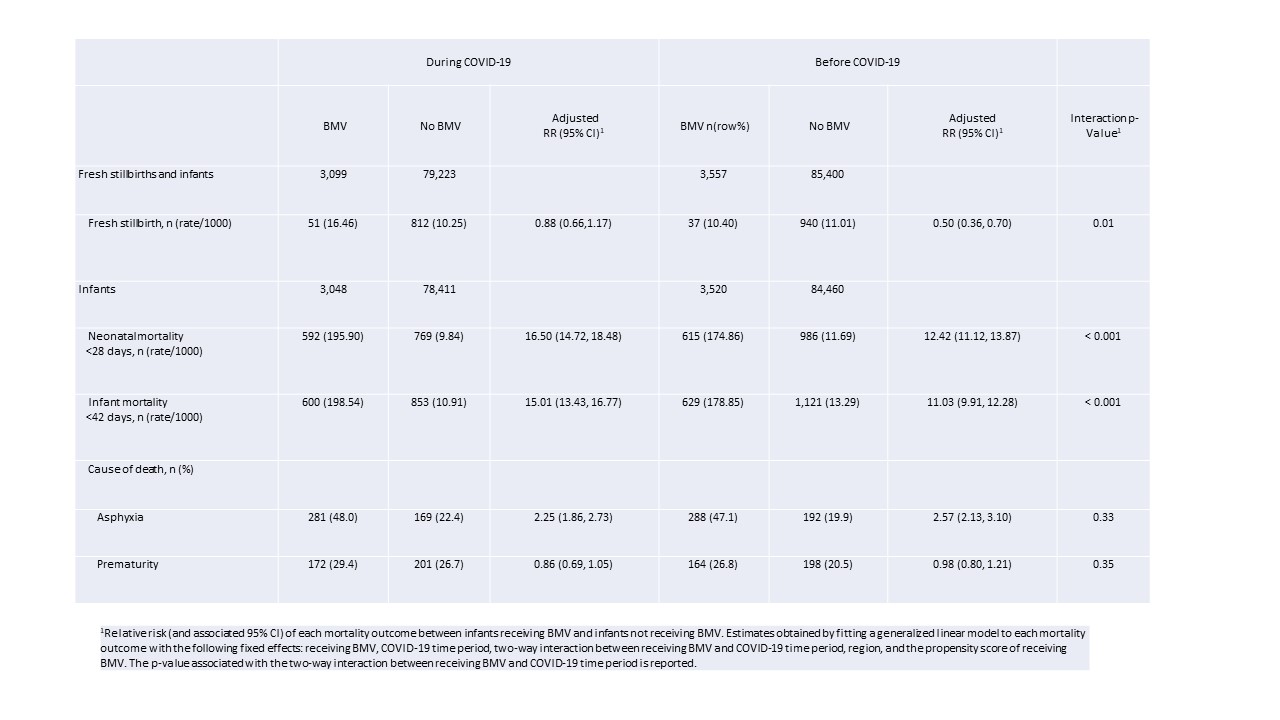Global Neonatal & Children's Health
Session: Global Neonatal & Children's Health 2
498 - Bag and Mask Ventilation at Birth Before and During the COVID-19 Pandemic: A Secondary Analysis from the Global Network Maternal Newborn Health Registry
Friday, May 3, 2024
5:15 PM - 7:15 PM ET
Poster Number: 498
Publication Number: 498.434
Publication Number: 498.434

Zubair H. Aghai, MD (he/him/his)
Professor of Pediatrics
Sidney Kimmel Medical College at Thomas Jefferson University
Philadelphia, Pennsylvania, United States
Presenting Author(s)
Background: Birth asphyxia, defined by WHO as a failure to initiate and sustain spontaneous breathing at birth, is one of the leading causes of neonatal deaths worldwide. Infants who failed to establish spontaneous breathing at birth may receive bag and mask ventilation (BMV). The impact of COVID-19 pandemic on the risk of receiving BMV is not well-studied. The pandemic likely impacted the training and skills for resuscitation and outcomes in infants who received BMV.
Objective: To compare the proportion of fresh stillbirth and infants receiving BMV at birth before and during the COVID-19 pandemic using Global Network data from the Maternal Newborn Health Registry. To determine the difference in mortality outcomes for those receiving BMV and to those not receiving BMV before and during the COVID-19 pandemic.
Design/Methods: This is a secondary analysis of prospectively collected data from the seven sites of the Global Network. All fresh stillbirths and live births reported in the registry with BW ≥ 1500 grams between January 2017 and April 2023 were included (before COVID-19 period, 01/01/2017 to 02/29/2020; during COVID-19 period 03/01/2020 to 04/30/2023). The maternal and neonatal demographics, clinical characteristics, use of BMV at birth, rates of fresh stillbirths, neonatal mortalities (1-28 days) and mortalities between 1-42 days were compared between the ‘Before’ and ‘During’ COVID-19 periods. Relative risk of each mortality by BMV was adjusted for region, COVID-19 period, two-way interaction between COVID-19 period and BMV, and the propensity score of receiving BMV.
Results: A total of 171,279 births [88,957 Before COVID-19 period (51.9%) and 82,322 (48.1%) During COVID-19 period] were included in the analysis [169,439 live births (98.9%) and 1,840 fresh stillbirths (1.1%)]. A total of 3,099 (3.8%) received BMV during and 3,557 (4.0%) received BMV before COVID-19 [RR (95% CI) 0.95(0.90,0.99)]. For births that required BMV, the rate for fresh stillbirths was higher during the COVID-19 period (16.46/1000) compared to before the COVID-19 period (10.4/1000, p=0.01 two-way interaction between receiving BMV and COVID-19 period). Similarly, the rates for neonatal mortality and infant mortality < 42 days among those receiving BMV were higher during the COVID-19 period (Table 1).
Conclusion(s): The proportion of fresh stillbirths and live newborns who received BMV at birth was lower during the COVID-19 pandemic. However, the rates of fresh stillbirths, neonatal and early infant mortality in deliveries that received BMV during the COVID-19 pandemic was higher compared to the rates that received BMV before COVID-19.

